This is section 2, covering sheets 11 through 20 of 65 pages from the archives of the U.S. Navy in a declassified document.
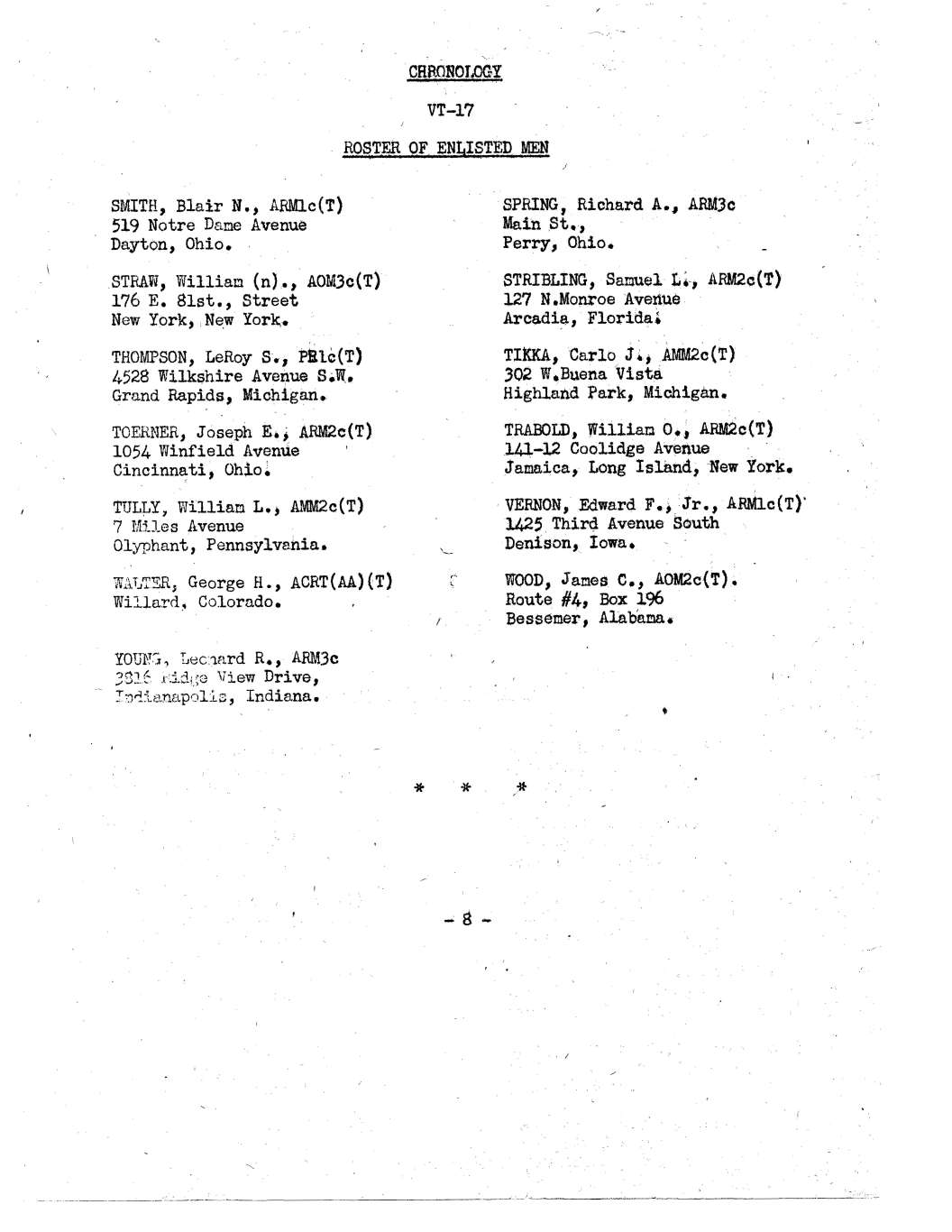
CHRONOLOGY
VT-17
ROSTER OF ENLISTED MEN
SMITH, Blair N., ARM1c(T), 519 Notre Dame Avenue, Dayton, Ohio.
SPRING, Richard A., ARM3c, Main St., Perry, Ohio.
STRAW, William (n)., AOM3c(T), 176 E. 81st Street, New York, New York
STRIBLING, Samuel L., ARM2c(T), 127 N. Monroe Avenue, Arcadia, Florida.
THOMPSON, LeRoy S., PB1c(T), 4528 Wilkshire Avenue S.W., Grand Rapids, Michigan.
TIKKA, Carlo J., AMM2c(T), 302 W. Buena Vista, Highland Park, Michigan.
TOENER, Joseph E., ARM2c(T), 1054 Winfield Avenue, Cincinnati, Ohio.
TRABOLD, William O., ARM2c(T), 141-12 Collidge Avenue, Jamaica, Long Island, New York.
TULLY, William L., AMM2c(T), 7 Miles Avenue, Olyphant, Pennsylvania.
VERNON, Edward F., Jr., ARM1c(T), 1425 Third Avenue South, Denison, Iowa.
WALTER, George H. ACRT(AA)(T), Willard, Colorado
WOOD, James C. (AOM2c(T), Route #4, Box 196, Bessemer, Alabama.
YOUNG, Leonard R., ARM3c, 3816 Ridge View Drive, Indianapolis, Indiana.
* * *
– 8 –
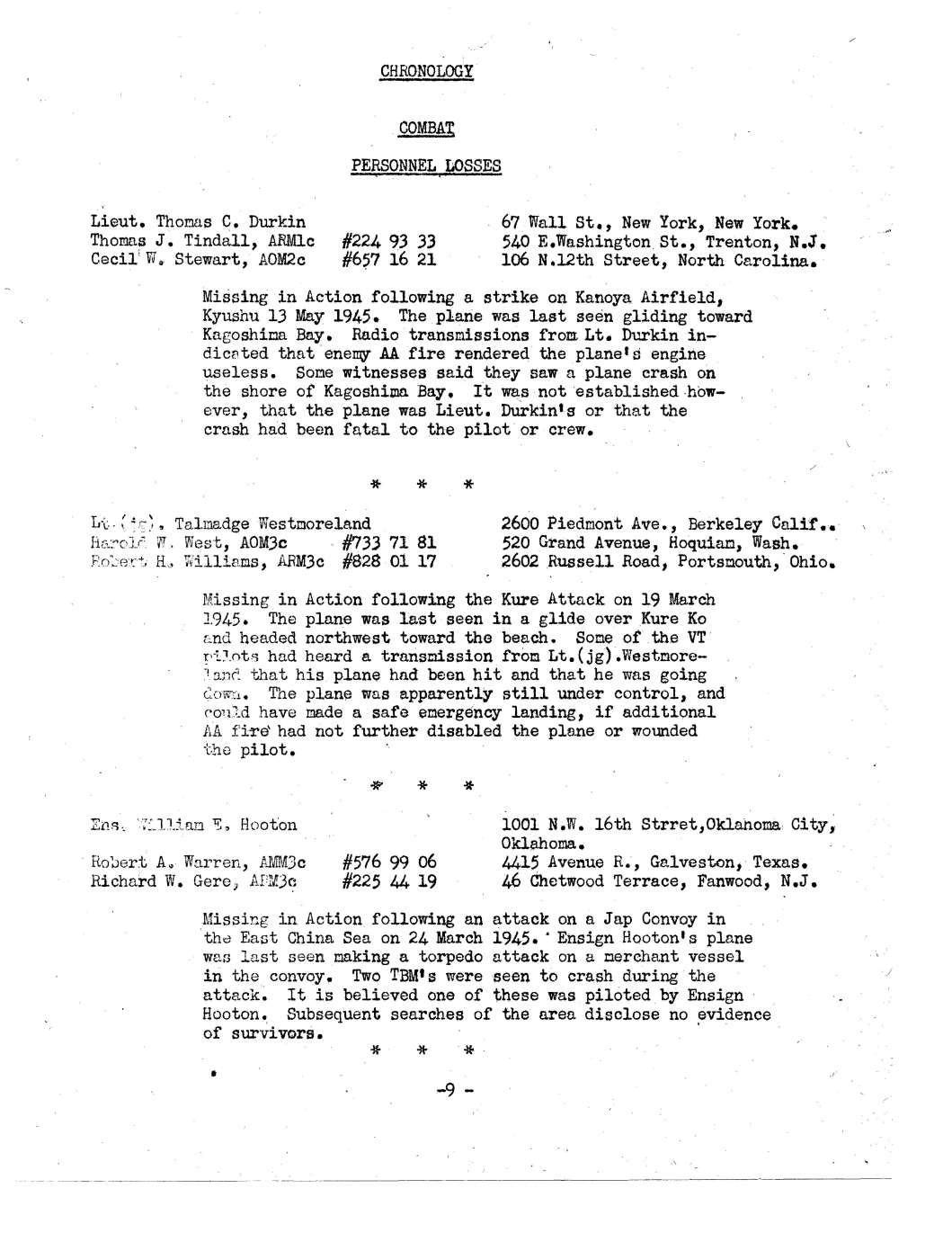
CHRONOLOGY
COMBAT
PERSONNEL LOSSES
Lieut. Thomas C. Durkin 67 Wall St., New York, New York.
Thomas J. Tindall, ARM1c #224 93 33, 540 E. Washington St., Trenton, N.J.
Cecil W. Stewart, AOM2c #657 16 21, 106 N. 12 Street, North Carolina
Missing in Action following a strike on Kanoya Airfield, Kyushu 12 May 1945. The plane was last seen gliding toward Kagoshima Bay. Radio transmissions from Lt. Durkin indicated that enemy AA fire rendered the plane’s engine useless. Some witnesses said they saw a plane crash on the shore of Kagoshima Bay. It was ont established however, that the plane was Lieut. Dukin’s or that the crash had been fatal to the pilot or crew.
* * *
Lt. (jg). Talmadge Westmoreland, 2600 Piedmont Ave., Berkeley, Calif.
Harold F. West, AOM3c, #733 71 81, 520 Grand Avenue, Hoquiam, Wash.
Robert H. Williams, ARM3c, #828 01 17, 2602 Russell Road, Portsmouth, Ohio.
Missing in Action following the Kure Attack on 19 March 1945. The plane was last seen in a glide over Kure Ko and headed northwest toward the beach. Some of the VT pilots had heard a transmission from Lt.(jg). Westmoreland that his plane had been hit and that he was going down. The plane was apparently still under control, and could have made a safe emergency landing, if additional AA fire had not further disabled the plane or wounded the pilot.
* * *
Ens. William E. Hooton, 1001 N.W. 16th Street, Oklahoma City, Oklahoma.
Robert A. Warren, AMM3c, #576 99 06, 4415 Avenue R., Galveston, Texas.
Richard W. Gere, ARM3c, #225 44 19, 46 Chetwood Terrace, Fanwood, N.J.
Missing in Action following an attack on a Jap Convoy in the East China Sea on 24 March 1945. Ensign Hooton’s plane was last seen making a torpedo attack on a merchant vessel in the convoy. Two TBM’s were seen to crash during the attack. It is believed one of these was piloted by Ensign Hooton. Subsequent searches of the area disclose no evidence of survivors.
* * *
– 9 –
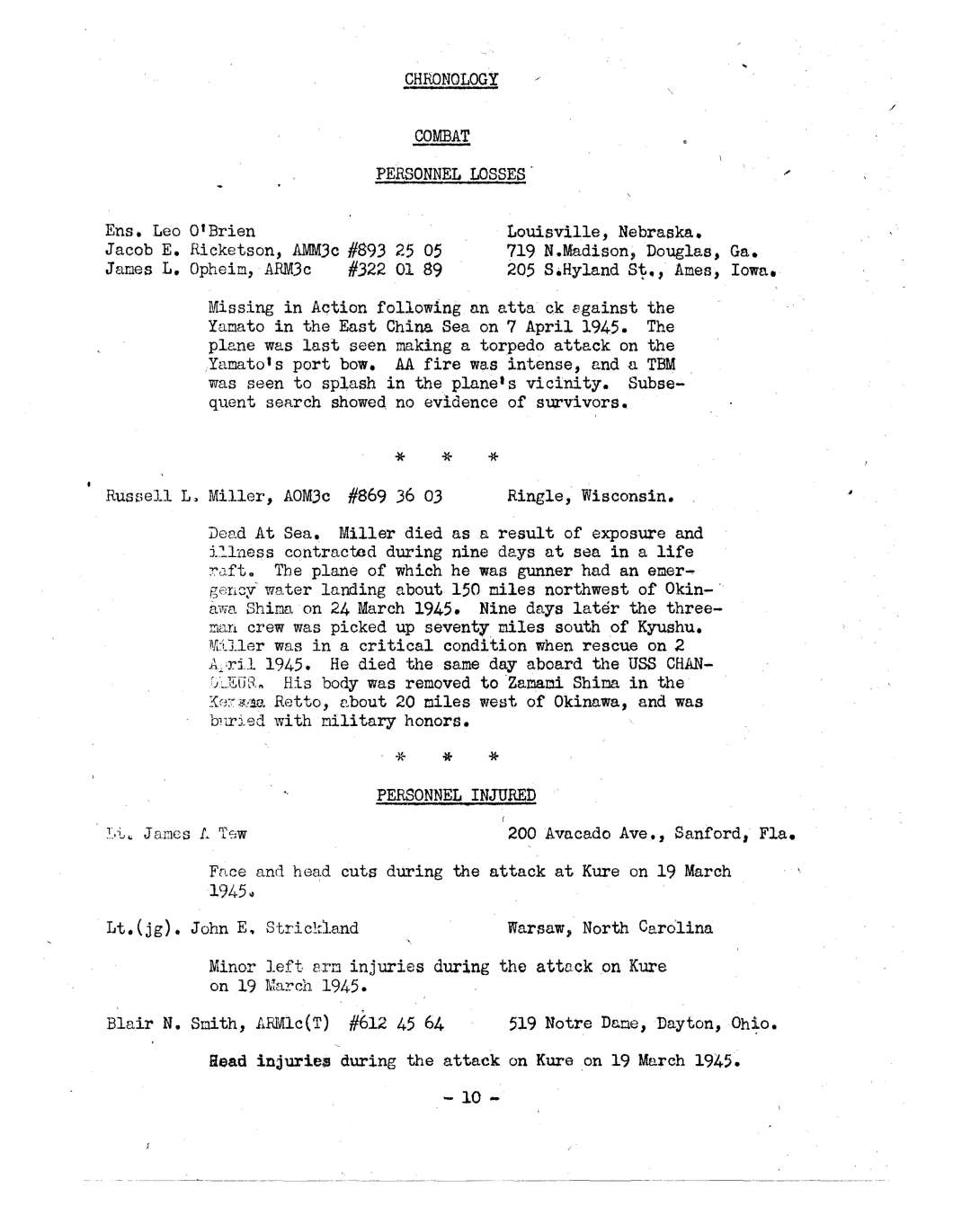
CHRONOLOGY
COMBAT
PERSONNEL LOSSES
[TBF Avenger crew]
Ens. Leo O’Brien, Louisville, Nebraska. [pilot]
Jacob E. Ricketson, AMM3c, #893 25 05, 719 N. Madison, Douglas, Ga. [gunner]
James L. Opheim, ARM3c, #322 01 89, 205 S. Hyland St., Ames, Iowa. [Radar/Navigator]
Missing in Action following an attack against the Yamato in the East China Sea on 7 April 1945. The plane was last seen making a torpedo attack on the Yamato’s port bow. AA fire was intense, and a TBM was seen to splash in the (Yamato’s) vicinity. Subsequent search shows no evidence of survivors.
* * *
Russell L. Miller, AOM3c, #869 36 03, Ringle, Wisconsin.
Deat At Sea. Miller died as a result of exposure and illness contracted during nine days at sea in a life raft. The plane of which he was gunner had an emergency water landing about 150 miles northeast of Okinawa Shima on 24 March 1945. Nine days later the three-man crew was picked up seventy miles south of Kyushu. Miller was in a critical condition when rescue on 2 April 1945. He died the same day abouard the USS CHANDLER. His body was removed to Zamami Shima in the (Kerava) Retto, about 20 miles west of Okinawa, and was buried with military honors.
* * *
PERSONNEL INJURED
Lt. James A Tew, 200 Avacado, Sanford, Fla.
Face and head cuts during the attack at Kure on 19 March 1945.
Lt.(jg). John E. Strickland, Warsaw, North Carolina.
Minor left arm injuries during the attack on Kure on 19 March 1945.
Blair N. Smith, (ARM1c(T), #612 45 64, 519 Notre Dame, Dayton, Ohio.
Head injuries during the attack on Kure on 19 March 1945.
– 10 –
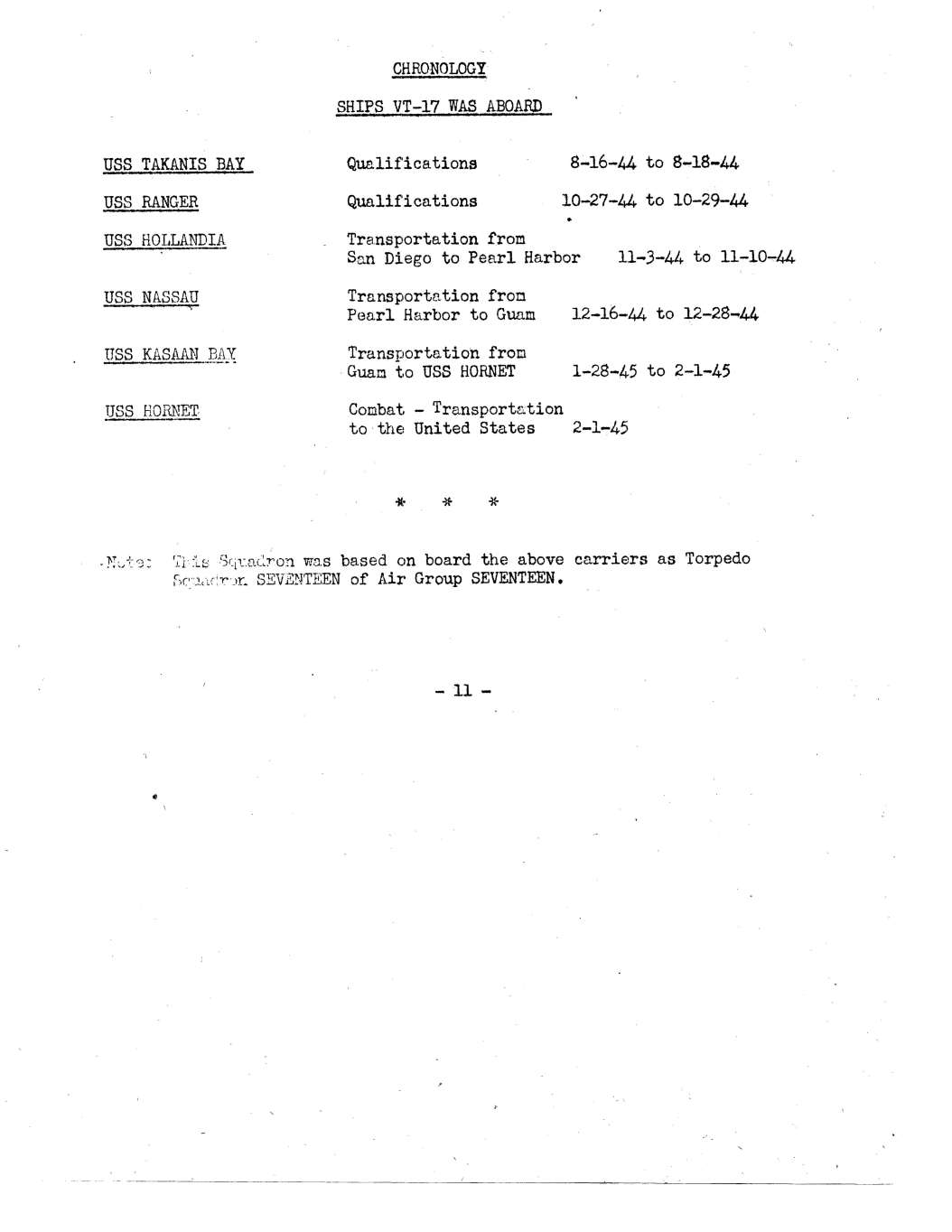
CHRONOLOGY
SHIPS VT-17 WAS ABOARD
USS TAKANIS BAY, Qualifications, 8-16-44 to 8-18-44
USS RANGER, Qualifications, 10-27-44 to 10-29-44
USS HOLLANDIA, Transportation from San Diego to Pearl Harbor, 11-3-44 to 11-10-44
USS NASSAU, Transportation from Pearl Harbor to GUAM, 12-16-44 to 12-28-44
USS KASAAN BAY, Transportation from Guam to USS HORNET, 1-28-45 to 2-1-45
USS HORNET, Combat – Transportation to the United States, 2-1-45 to
* * *
Note: This Squadron was based on board the above carriers as Torpedo Squadron SEVENTEEN of Air Group SEVENTEEN.
– 11 –
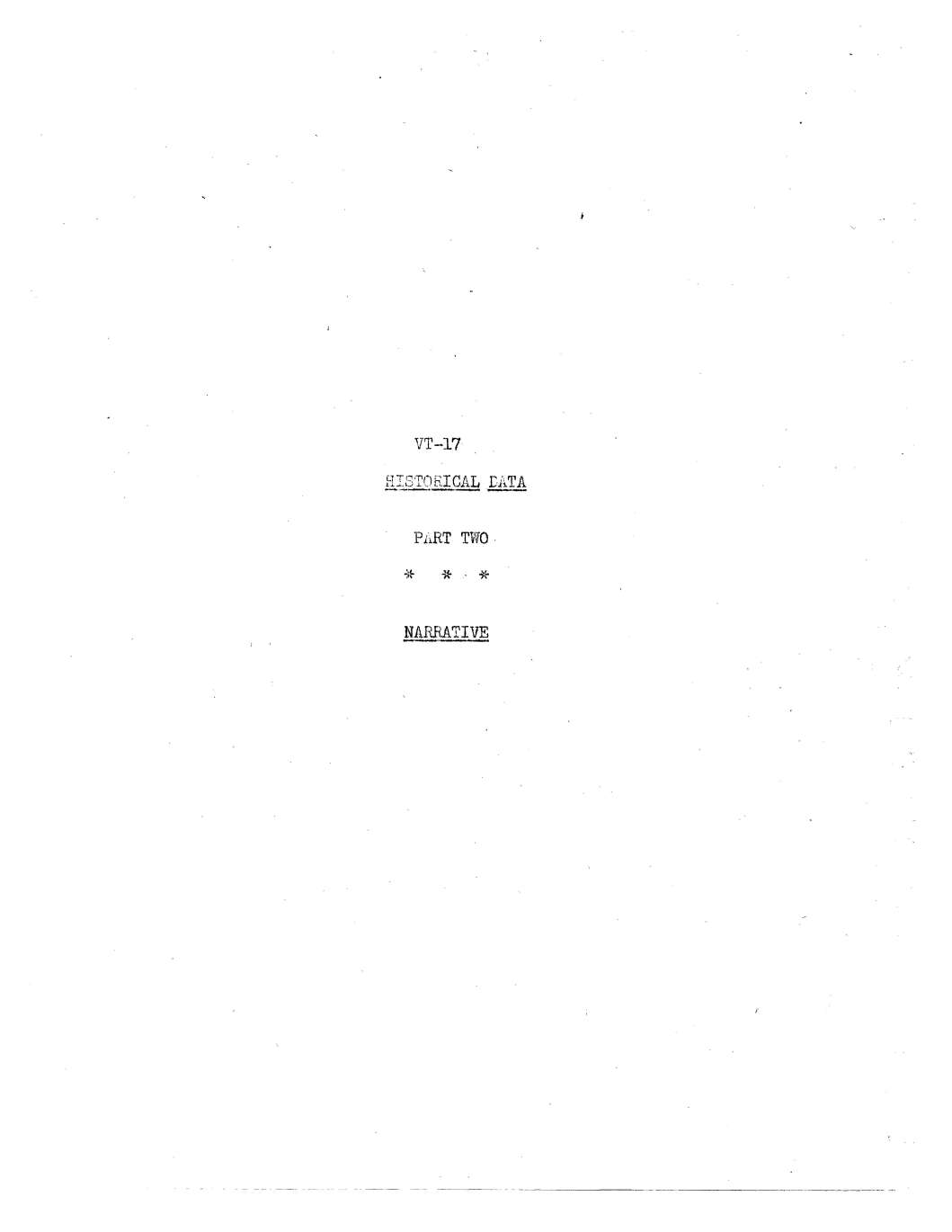
VT-17
HISTORICAL DATA
PART TWO
* * *
NARRATIVE
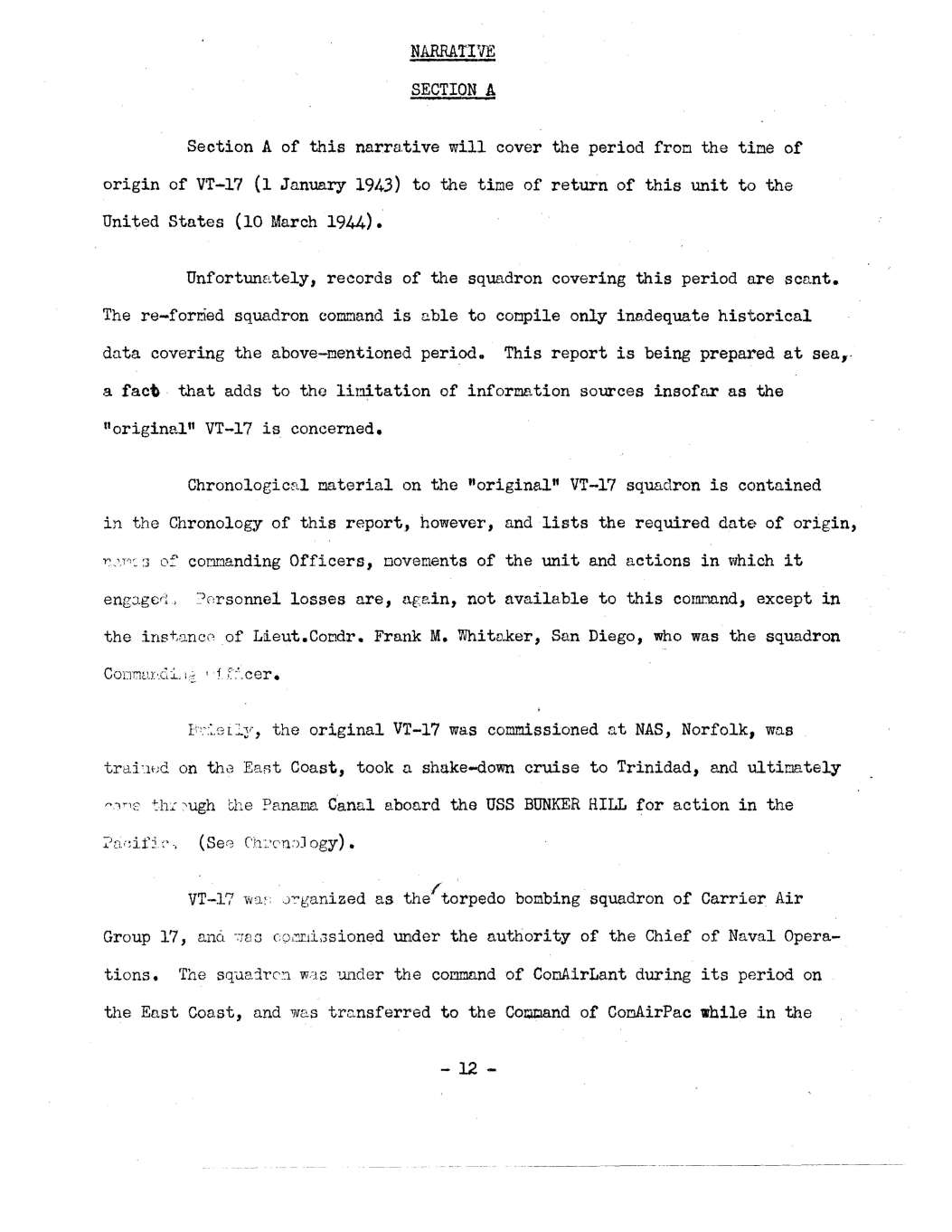
NARRATIVE
SECTION A
Section A of this narrative will cover the period from the time of origin of VT-17 (1 January 1943) to the time of return of this unit to the United States (10 March 1944).
Unfortunately, records of the squadron covering this period are scant. The re-formed squadron command is able to compile only inadequate historical data covering the above-mentioned period. This report is being prepared at sea, a fact that adds to the limitation of information soures insofar as the “original” VT-17 is concerned.
Chronological material on the “original” VT-17 squadron is contained in the Chronology of this report, however, and lists the required date of origin, names of commanding Officers, movements of the unit and actions in which it engaged. Personnel losses are, again, not available to this command, except in the instance of Lieut. Comdr. Frank M. Whitaker, San Diego, who was the squadron Commanding Officer.
Briefly, the original VT-17 was commissioned at NAS Norfolk, was trained on the East Coast, took a shake-down cruise to Trinidad, and ultimately came through the Panama Canal aboard the USS BUNKER HILL for action in the Pacific. (See Chronology).
VT-17 was organized as the torpedo bombing squadron of Carrier Air Group 17, and was commissioned under the authority of the Chief of Naval Operations. The squadron was under the command of ComAirLant during its period on the East Coast, and was transferred to the Command of ComAirPac while in the
– 12 –
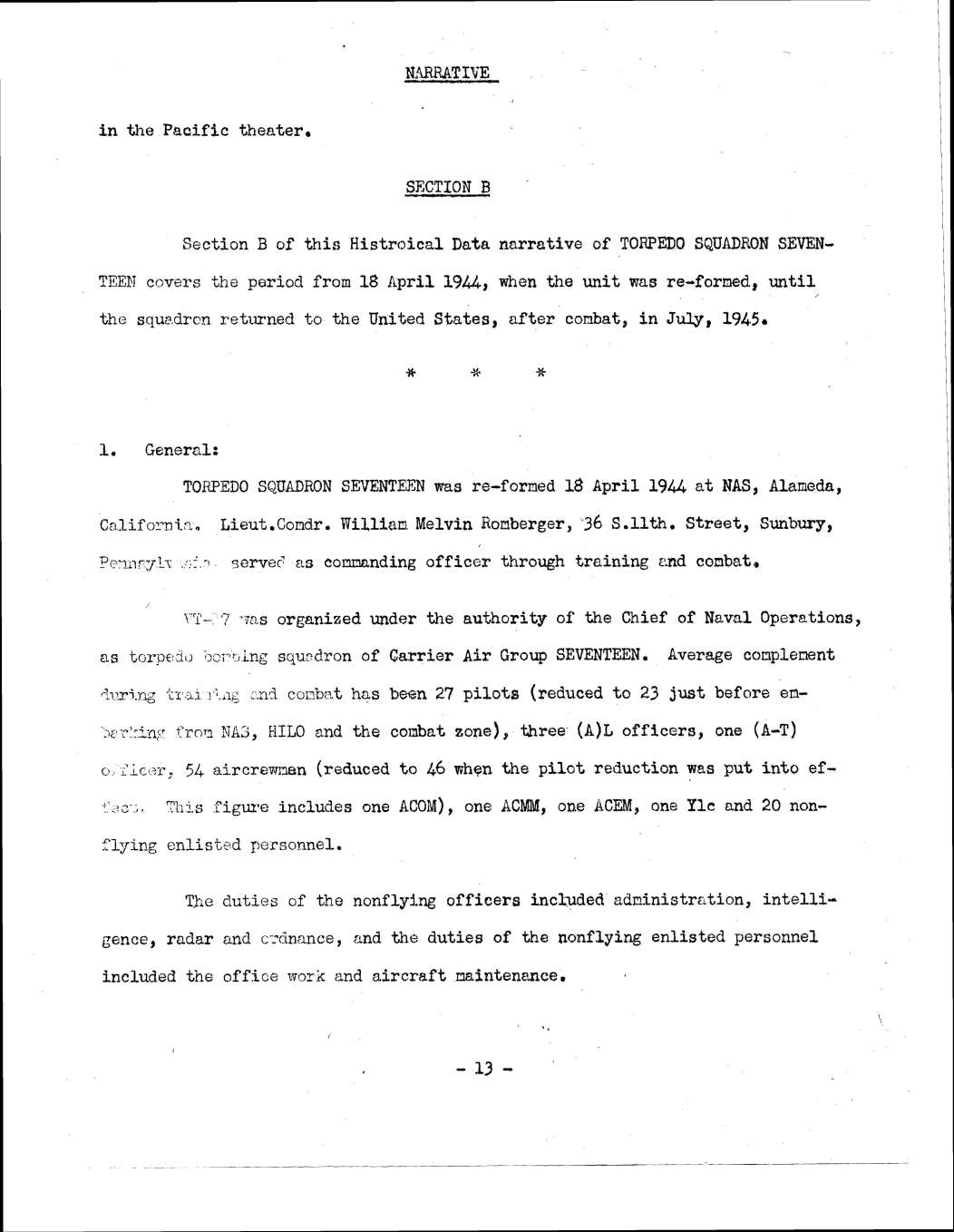
NARRATIVE
in the Pacific theater.
SECTION B
Section B of this Historical Data narrative of TORPEDO SQUADRON SEVENTEEN covers the period from 18 April 1944, when the unit was re-formed, until the squadron returned to the United States, after combat, in July, 1945.
* * *
1. General: TORPEDO SQUADRON SEVENTEEN was re-formed 18 April 1944 at NAS Alameda, California. Lieut. Comdr. William Melvin Romberger, 36 S. 11th Street, Sunbury, Pennsylvania served as commanding officer through training and combat.
VT-17 was organized under the authority of the Chief of Naval Operations, as torpedo bombing squadron of Carrier Air Group SEVENTEEN. Average complement during training and combat has been 27 pilots (reduced to 23 just before embarking from NAS HILO and the combat zone), three (A)L officers, one (A-T) officer, 54 aircrewman (reduced to 46 when the pilot reduction was put into effect. This figure includes one ACOM), one ACMM, one ACEM, one Y1c and 20 non-flying enlisted personnel.
The duties of the nonflying officers included administration, intelligence, radar and ordinance, and the duties of the nonflying enlisted personnel included the office work and aircraft maintenance.
– 13 –
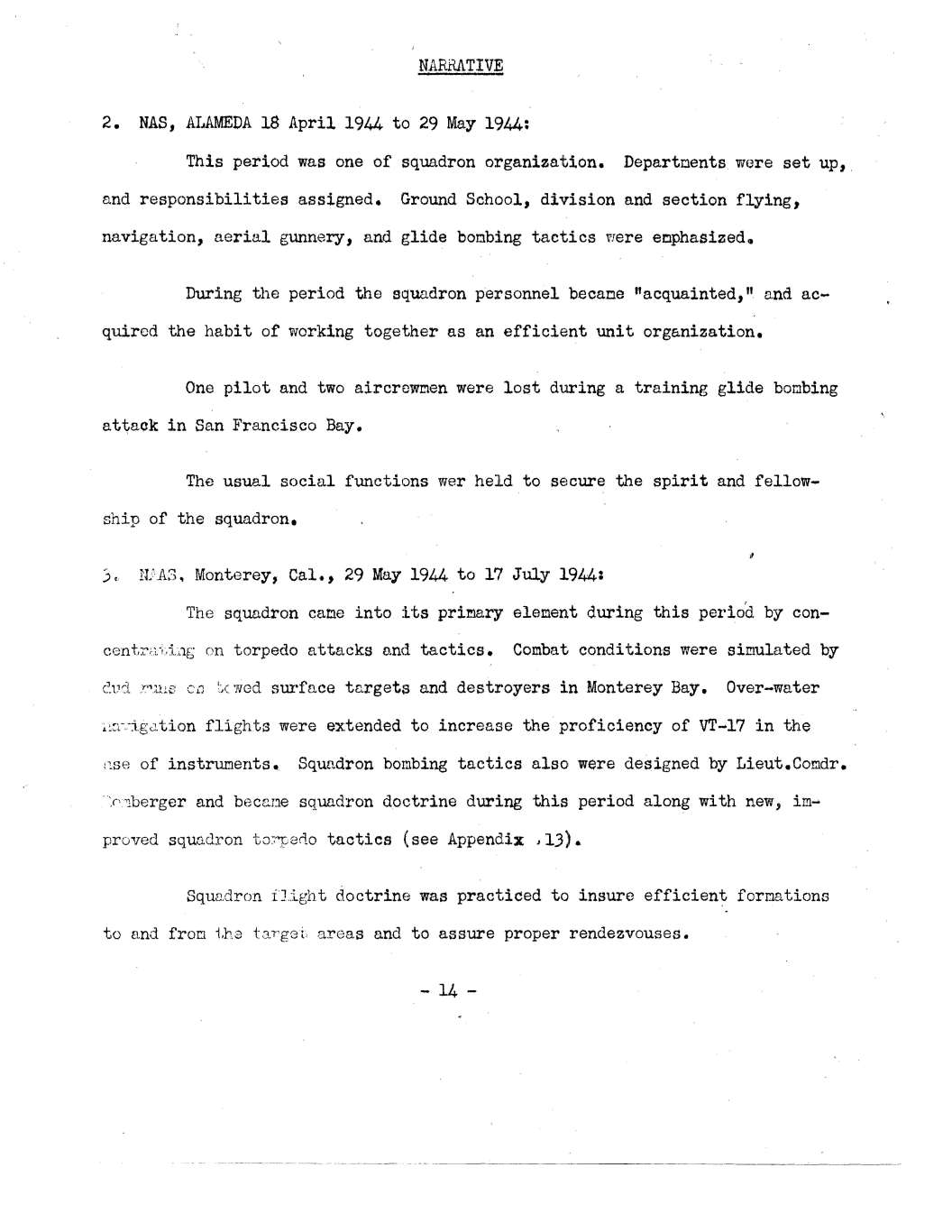
NARRATIVE
2. NAS ALAMEDA 18 April 1944 to 29 May 1944:
This period was one of squadron organization. Departments were set up, and responsibilities assigned. Ground School, division and section flying, navigation, aerial gunnery, and glide bombing tactics were emphasized.
During the period the squadron personnel became “acquaintedn” and acquired the habit of working together as an efficient unit organization.
One pilot and two aircrewmen were lost during a training glide bombing attack in San Francisco Bay.
The usual social functions were held to secure the spirit and fellowship of the squadron.
3. NAAS Monterey, Cal, 29 May 1944 to 17 July 1944:
The squadron came into its primary element during this period by concentrating on torpedo attacks and tactics. Combat conditions were simulated by dud runs on bowed surface targets and destroyers in Monterey Bay. Over-water navigation flights were extended to increase the proficiency of VT-17 in the use of instruments. Squadron bombing tactics also were designed by Lieut. Comdr. Romberger and became squadron doctrine during this period along with new improved squadron torpedo tactics (see Appendix 13).
Squadron flight doctrine was practiced to (ensure) efficient formations to and from the target areas and to assure proper rendezvouses.
– 14 –
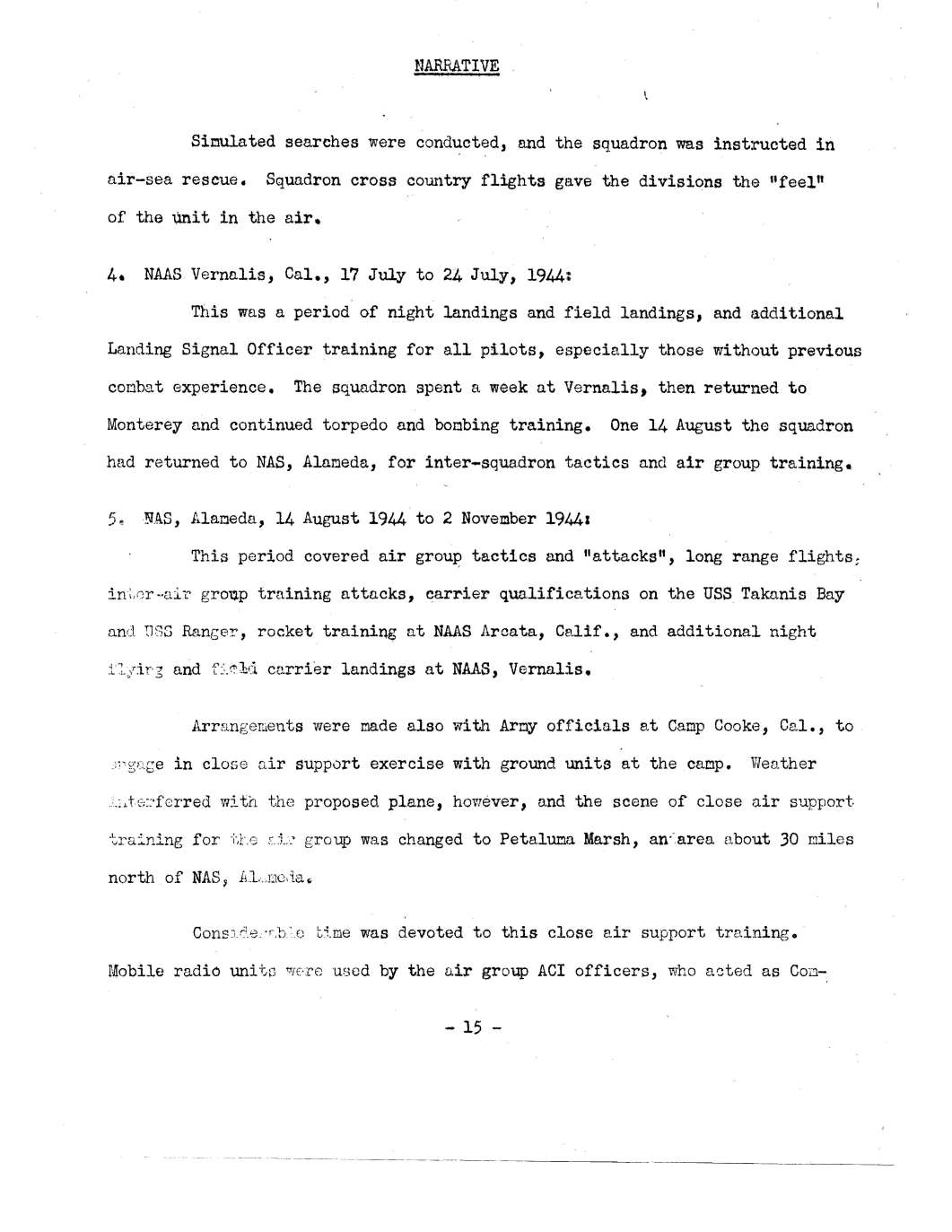
NARRATIVE
Simulated searches were conducted, and the squadron was instructed in air-sea rescue. Squadron cross country flights gave the divisions the “feel” of the unit in the air.
4. NAAS Vernalis, Cal., 17 July to 24 July, 1944:
This was a period of night landing and field landings, and additional Landing Signal Officer training for all pilots, especially those without previous combat experience. The squadron spent a week at Vernalis, then returned to Monterey and continued torpedo and bombing training. On 14 August the squadron had returned to NAS Alameda for inter-squadron tactics and air group training.
5. NAS Alameda, 14 August 1944 to 2 November 1944:
This period covered air group tactics and “attacks”, long range flights, inter-air group training attacks, carrier qualifications on the USS Takanis Bay and USS Ranger, rocket training at NAAS Arcata, Calif., and additional night flying and field carrier landings at NAAS Vernalis.
Arrangements were made also with Army officials at Camp Cooke, Cal., to engage in close air support exercise with ground units at the camp. Weather interfered with the proposed plan, however, and the scene of close air support training for the air group was changed to Petaluma Marsh, an area about 30 miles north of NAS Alameda.
Considerable time was devoted to this close air support training. Mobile radio units were used by the air group ACI officers, who acted as Com-
– 15 –
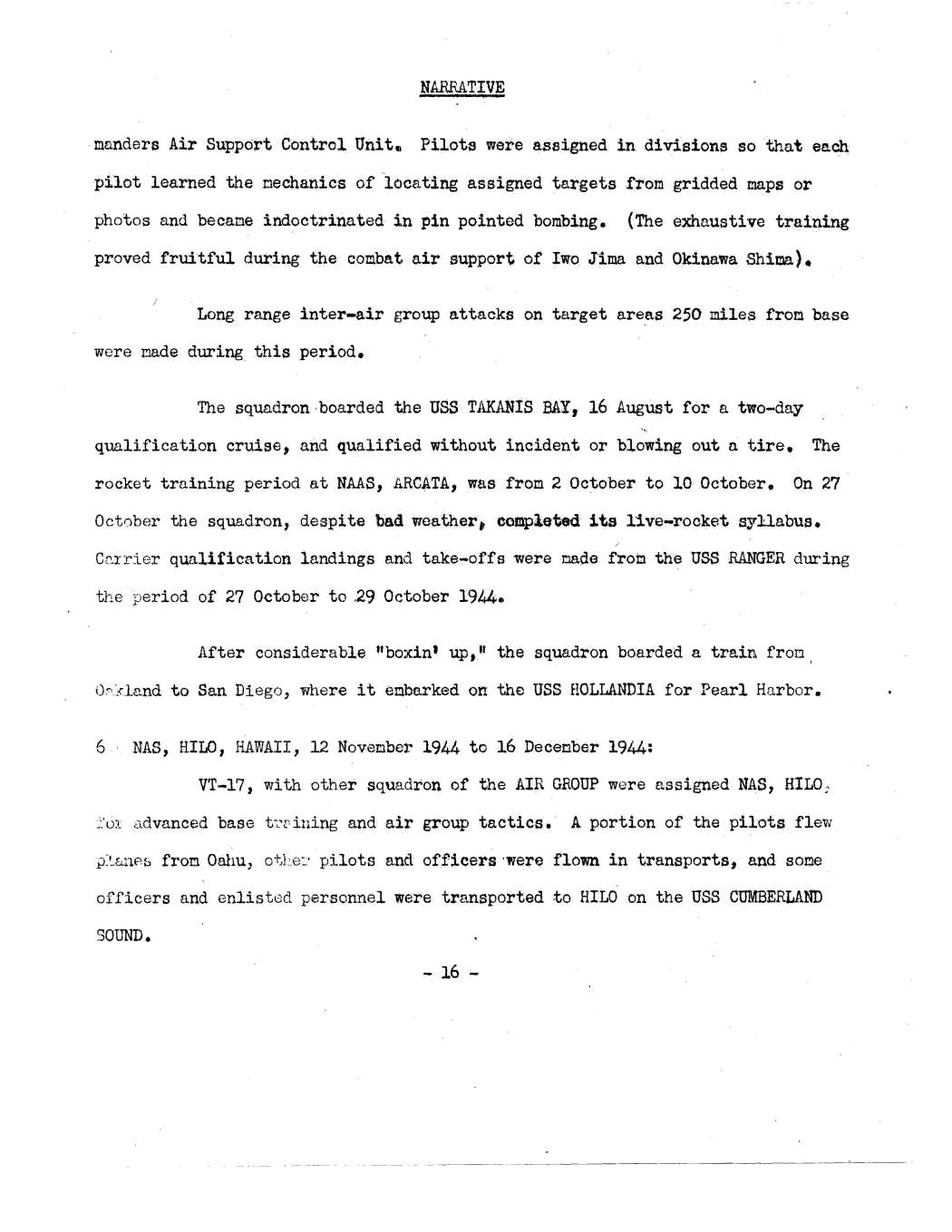
NARRATIVE
manders Air Support Control Unit. Pilots were assigned in divisions so that eacy pilot learned the mechanics of locating assigned targets from gridded maps or photos and became indoctrinated to pin pointed bombing. (The exhaustive training proved fruitful during the combat air support of Iwo Jima and Okinawa Shima).
Long range inter-air group attacks on target areas 250 miles from base were made during this period.
The squadron boarded the USS TAKANIS BAY, 16 August for a two-day qualification cruise, and qualified without incident or blowing out a tire. The rocket training period at NAAS ARCATA, was from 2 October to 10 October. On 27 October the squadron, despite bad weather, completed its live-rocket syllabus. Carrier qualification landings and take-offs were made from the USS RANGER during the period 27 October to 29 October 1944.
After considerable “boxin’ up,” the squadron boarded a train from Oakland to San Diego, where it embarked on the USS HOLLANDIA for Pearl Harbor.
6. NAS HILO, HAWAII, 12 November 1944 to 16 December 1944:
VT-17, with other squadron of the AIR GROUP were assigned NAS HILO for advanced base training and air group tactics. A portion of the pilots flew planes from Oahu, other pilots and officers were flown in transports, and some officers and enlisted personnel were transported to HILO on the USS CUMBERLAND SOUND.
– 16 –
(continued)
VT-17 Historical Report by W. M. Romberger : Click – Part 1 – Part 2 – Part 3 – Part 4 – Part 5 – Part 6 – Part 7


 Donations appreciated.
Donations appreciated.